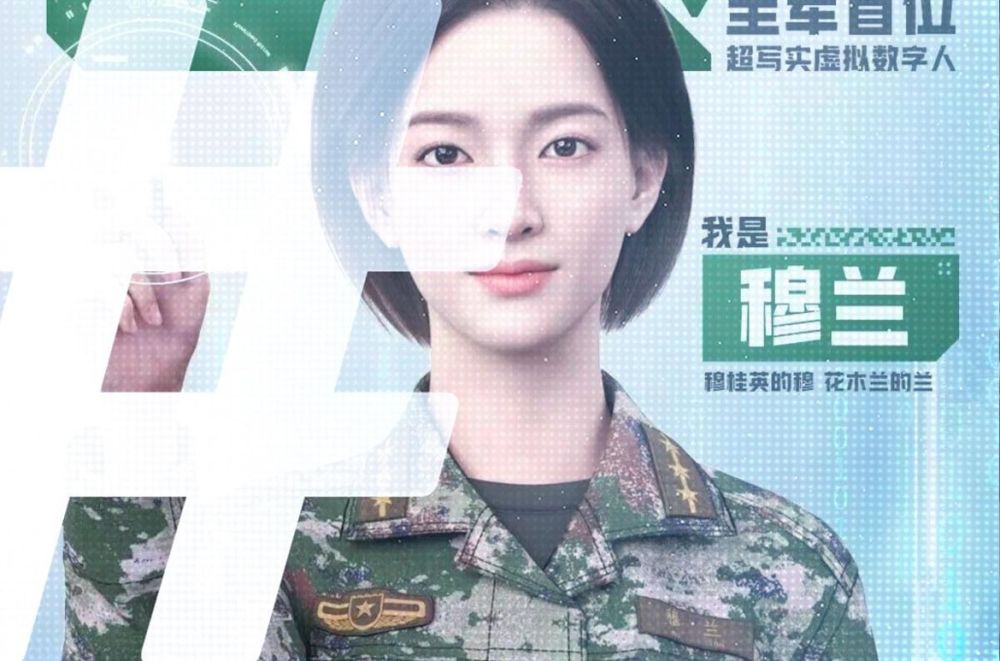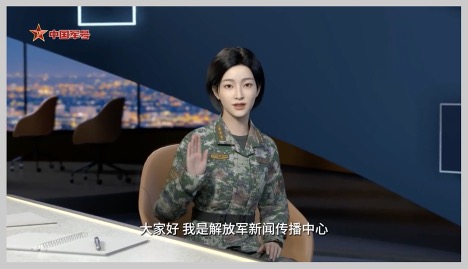
When it comes to the latest updates from China’s vast and powerful military establishment, face-time with a thinking, breathing human would be a reasonable hope for anyone.
But the People’s Liberation Army (PLA) has other ideas. In November last year, the China Bugle (中国军号), the flagship news outlet of the PLA Press and Communication Center (解放军新闻传播中心), introduced their AI anchor “Mulan” (穆兰) to the world. Billed as the military force’s first “digital journalist,” Mulan is a bob-haired, bright-eyed young woman named after two of China’s most famous female warriors: Mu Guiying (穆桂英) and Hua Mulan (花木兰). China Bugle assures readers she will “fight side-by-side” with military reporters, do live news broadcasts, and “convey more positive energy for a strong army” — this last phrase being a Xi-era term that refers to the need for uplifting messages as opposed to critical or negative ones.
Mulan made her on-screen debut in March this year, on the same day that the annual Two Sessions opened in Beijing. In a dramatic, action-packed trailer, Mulan was pictured parachuting into a jungle, shooting targets, and leaping through cyberspace — demonstrating her prowess with both tech and real-world combat. Since then, she has appeared on PLA social media accounts across multiple platforms, interviewing armed forces experts, explaining current military affairs, appearing as a presenter on a PLA variety show for young people, and even hosting a VR program honoring PLA heroes and martyrs for this year’s Qingming Festival.
The Unreality of State Media
It’s all part of a drive to get people more engaged with the PLA through the latest tech. Over the past ten years, multiple state-run outlets have worked on developing their own apps and becoming social media savvy to keep audiences engaged. This coincides, now, with a separate drive to push the use of AI in media.

In 2015, Xi Jinping made it clear that the military needs to keep up with the latest media trends: “Wherever readers are, wherever viewers are, that is where propaganda reports must extend their tentacles,” he told an audience at the PLA Daily. An article from the editors of the Military Correspondent (军事记者), another publication under the PLA Press and Communication Center, lists Mulan as one outcome of these instructions from the top.
Mulan, of course, is no journalist. Despite claiming to travel to the frontlines to “interview” the soldiers there, she is little more than a digital mascot, there to redirect news consumers to the China Bugle app, which was launched at the same time as Mulan.
Since her spectacular debut, actual appearances of Mulan have been few and far between, with just two short videos on China Bugle’s Kuaishou account and three on Douyin. Mulan also seems to distract viewers from the news she’s presenting — under one of her Douyin explainers, every comment was about Mulan herself rather than the issues she explored.
Among these comments were criticisms of Mulan appearing “fake” or “awkward.” Her appearances often have her standing in a stiff pose, with a few formulaic hand gestures as she rattles off a script. This is not unlike the cookie-cutter poses of the AI anchors created by Zhongke Wenge (中科闻歌).
Some seemed to struggle to come to terms with what they were seeing. “I wasn’t sure for a few seconds,” wrote one user in the post’s most upvoted comment. “I had seriously look for while [to believe] this is the official account.” For others, an AI anchor wearing the stars of a captain was a step too far: “Digital people can use camouflage but can they not have military rank?” suggested another top comment. “To be honest, I still want to see real people,” read a third.

Will the Anchors Hold?
AI anchors have been sprouting up across multiple state-run outlets like International Communication Center iChongqing. Hong Kong’s RTHK (香港電台) has also leveraged AI to make up for “staff shortages” in the wake of mass resignations and firings as the government has brought the public broadcaster to heel. These serve as reminders of state media’s commitment to pushing “cutting-edge” AI, cutting costs, and churning out more content more rapidly than ever before.
Many of these anchors are putting off viewers with their uncanny-valley appearances, but companies like Qianxun (谦寻) and Wondershare Virbo (万兴播爆) may have found a way forward by creating remarkably life-like AI e-commerce live streamers for small-scale merchants trying to sell their wares overseas in multiple languages.
Qianxun’s owner has explained that the company deliberately collected real people’s faces to avoid creeping out viewers. Although this was costly, he believed it would lead to fewer people swiping to another video after immediately seeing the host was fake. Perhaps the most disturbing about these AI streamers is just how easy it is to make their videos.
CCTV Finance (央视财经), the financial news arm of the PRC state broadcaster, has also taken this approach. During the Two Sessions, the outlet uploaded much more natural AI replicas of two of their presenters to answer the public’s questions 24 hours a day. They also demonstrated the process by having another of their reporters uploaded. The process took two days, using only a five-minute recording of the reporter. A technician explained to the reporter that her AI doppelganger could be used to produce a short video in less than a day.

Although some Chinese media platforms are adopting this “real person upload” method, the technology isn’t quite there for everyone. Beijing’s Changping District Media Center (北京市昌平区融媒体中心) also uploaded one of their TV hosts for this year’s Two Sessions. In a video staging it as a surprise reveal for the real-life host, the AI anchor is placed side-by-side with his real-life counterpart. Unlike CCTV’s offering, it’s easy to spot the slick yet stiff “digital person.”
The sheer novelty of these creations is often enough to get views for now. The example of Mulan shows that even their unsettling and off-putting nature can spark lively debate online. But whether audiences will keep looking once the novelty wears off is another matter. Even when it comes to the state’s propaganda machine, the human touch cannot be easily replaced.




















